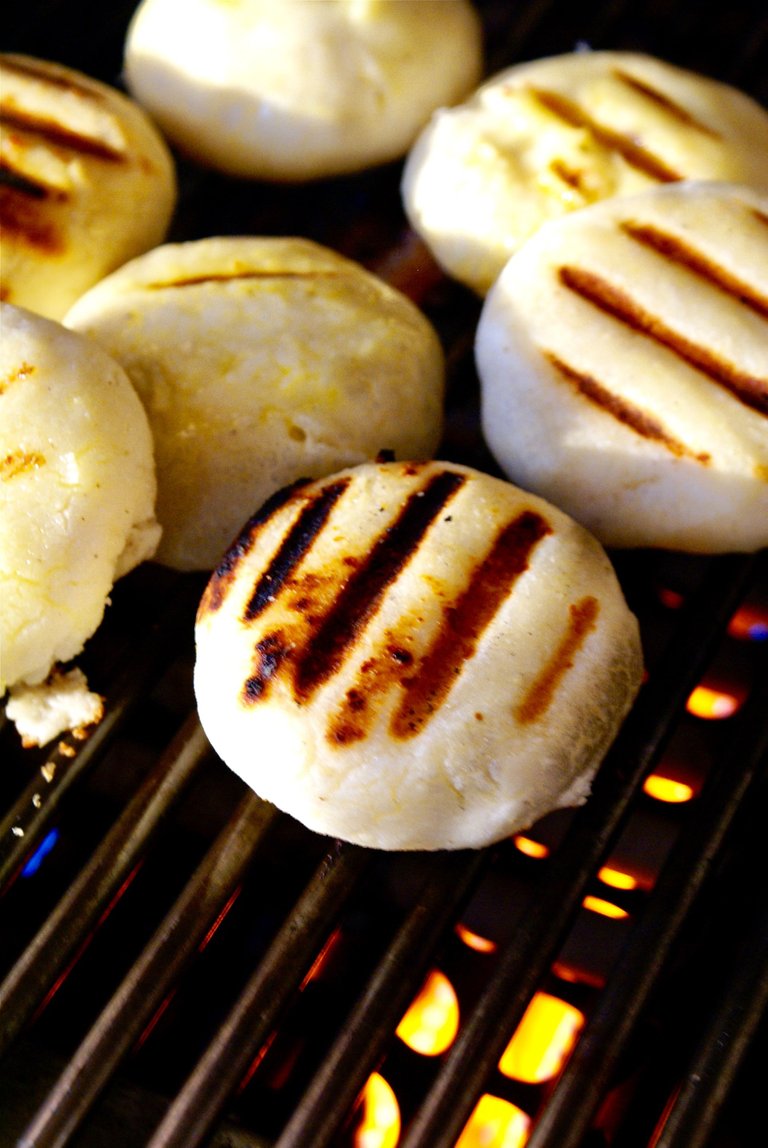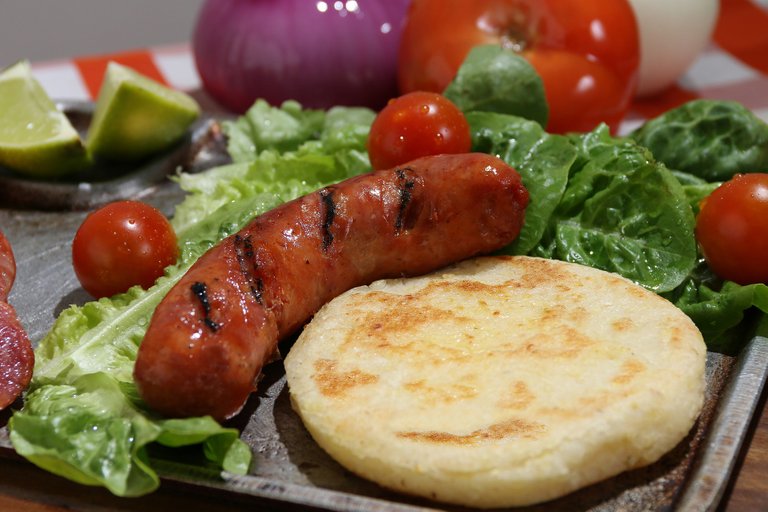Leyendo sobre la arepa he encontrado en algunos tuits, artículos y videos de la red que el origen de este alimento es un de tema de debate álgido entre venezolanos y colombianos por ser un plato típico de ambos pueblos. Todo este debate ha llamado mi atención; primero, por ser venezolano y, segundo, por ser un consumidor más de dicho alimento.
Aunque hay una buena cantidad de usuarios en Hive que saben qué es la arepa, no está demás definirla. Acá un concepto sencillo y bastante ilustrativo:
La arepa es una masa plana y redonda hecha de maíz que se puede cocinar a la plancha o en aceite.

Photo by Leila Issa on Unsplash
La palabra arepa fue aceptada por la Real Academia Española (RAE) en 1884.
Sobre los métodos de preparación tenemos las que son elaboradas de maíz pelado (acá no confundir con pilado) así como las hechas a partir de harina precocida. En ambos casos el maíz siempre está presente como materia prima. En cuanto a su textura y sabor hay variedades y diferencias entre la arepa colombiana y la venezolana. Además se puede rellenar con casi cualquier alimento. Por cierto, alguna vez por TV le oí decir a un chef venezolano: El único relleno con el que no combina son los espaguetis.

Photo by Martin Prieto on Pixabay
A pesar de las diferencias que puedan estar presentes entre la arepa de Colombia y la de Venezuela, vemos que la controversia no se encuentra allí, sino principalmente en su origen, ya que cada país afirma que nació en su territorio. Y es aquí donde quiero hacer hincapié.
Hurgando en la historia me encontré que la palabra arepa deriva de la voz cumanagoto, erepa. Los cumanagotos eran un grupo indígena que habitaba lo que hoy es el estado Sucre, Venezuela.
La primera mención histórica realizada sobre la arepa fue hecha por Galeotto Cey un comerciante europeo que vivió en Venezuela entre 1539 y 1553. En su manuscrito titulado Viaggio e Relazione delle Indie comenta que este alimento era consumido con frecuencia por los cumanagotos y agrega (Fragmento):
Hacen otra suerte de pan con el maíz a modo de tortillas, de un dedo de grueso, redondas y grandes como un plato a la francesa, o poco más o menos, y las ponen a cocer en una tortera sobre el fuego, untándolas con grasa para que no se peguen, volteándolas hasta que estén cocidas por ambos lados y a esta clase llaman areppas y algunos fecteguas.
Sin embargo, al hacer una revisión más profunda sobre el tema encontramos que el origen exacto no está claro por una razón; no se ha descubierto cuál fue el primer grupo indígena en realizar esta preparación. Algunos historiados comentan que algunas tribus descendientes de chibchas y caribes, que habitaban el noreste de Colombia, cultivaban el maíz, propiciando a la preparación de arepas. Pero al respecto no hay nada documentado. En lo que todos los autores si coinciden es que la arepa es un plato precolombino. Así que cuando no existían las fronteras que hoy separan a colombianos y venezolanos nuestros ancestros ya disfrutaban de este delicioso plato de comida.
A la pregunta ¿la arepa es venezolana o colombiana? dejo que cada uno la responda según su conocimiento. Puede que para algunos históricamente sea algo por ahora sin una respuesta definitiva. Lo cierto del caso es que tanto en Venezuela como en Colombia la arepa es considerada un plato que no puede faltar en la mesa de ninguna familia. Ojo, por ser venezolano sé que en nuestro país, en todos los rincones y a lo largo y ancho de la geografía se consume la arepa.
¿Qué me gusta de la arepa? Creo que su versatilidad porque hace posible que se amolde a cualquier estilo de vida, además de tener buen sabor y ser fácil de preparar.
Otros datos de interés:
- Hasta 2019 la compra de arepas en Colombia - según la agencia Raddar, que estudia hábitos de consumo alimenticio - había crecido en un 22% impulsada por la migración venezolana.
- De acuerdo a datos de Empresas Polar (corporación industrial venezolana cuyas actividades productivas abarcan productos de consumo masivo), suministrados para El Tiempo (periódico colombiano), en promedio un venezolano come 40 veces más arepa de maíz al año que un colombiano.
- En Colombia, en la costa atlántica, se celebra desde 1988 el Festival de la Arepa.
- Tiene una duración de tres días y consiste en reunir a cocineras que con al menos 5 años de experiencia en este arte culinario.
- En Venezuela la arepa se considera un patrimonio, y es parte de su cultura desde hace más de 400 años, tal como lo registran documentos de la época.
Referencias:
Libros:
- Pequeña Historia de la Arepa. Por Mariano Picón Salas (1966).
- Cocina Prehispánica. Por Lucía Rojas de Perdomo (1994).
- ¡Viva la arepa!: Sabor, memoria e imaginario social en Venezuela. Por Miguel Felipe Dorta Vargas (2015).
Sitios Web:
- https://www.easyespanol.org/blog/our-culture/historia-de-la-arepa/
- Arepa | Origen y Curiosidades Por actualidad-24.com/
- https://es.wikipedia.org/wiki/Arepa
Is Arepa Colombian or Venezuelan?
The word arepa was accepted by the Royal Spanish Academy (RAE) in 1884.
Reading about the arepa I have found in some tweets, articles and videos on the net that the origin of this food is a topic of heated debate between Venezuelans and Colombians for being a typical dish of both peoples. This whole debate has caught my attention; first, because I am Venezuelan and, second, because I am a consumer of this food.
Although there are a good number of Hive users who know what arepa is, it is not superfluous to define it. Here is a simple and illustrative concept:
The arepa is a flat, round dough made of corn that can be grilled or cooked in oil.

Photo by Leila Issa on Unsplash
Regarding the preparation methods, we have those made from peeled corn (not to be confused with pilado) as well as those made from pre-cooked flour. In both cases corn is always present as raw material. In terms of texture and flavor, there are varieties and differences between Colombian and Venezuelan arepas. Besides, it can be filled with almost any food. By the way, I once heard a Venezuelan chef say on TV: The only filling it does not combine with is spaghetti.

Photo by Martin Prieto on Pixabay
Despite the differences that may be present between the Colombian and Venezuelan arepa, we see that the controversy is not there, but mainly in its origin, since each country claims that it was born in its territory. And it is here where I want to emphasize.
Poking around in history I found that the word arepa derives from the voice cumanagoto, erepa. The Cumanagotos were an indigenous group that inhabited what is now the state of Sucre, Venezuela.
The first historical mention of the arepa was made by Galeotto Cey, a European merchant who lived in Venezuela between 1539 and 1553. In his manuscript entitled Viaggio e Relazione delle Indie he comments that this food was frequently consumed by the Cumanagotos and adds (Fragment):
They make another kind of bread with the corn in the manner of tortillas, a finger thick, round and large like a French dish, or a little more or less, and they put them to cook in a tortera over the fire, basting them with fat so that they do not stick, turning them until they are cooked on both sides and this kind they call areppas and some call them fecteguas.
However, when making a deeper review on the subject we find that the exact origin is not clear for one reason; it has not been discovered which was the first indigenous group to make this preparation. Some historians comment that some tribes descending from Chibchas and Caribs, who inhabited the northeastern part of Colombia, cultivated corn, which was conducive to the preparation of arepas. But there is nothing documented in this regard. What all authors agree on is that the arepa is a pre-Columbian dish. So when the borders that today separate Colombians and Venezuelans did not exist, our ancestors already enjoyed this delicious food dish.
To the question: Is the arepa Venezuelan or Colombian? I leave it to each one to answer according to their own knowledge. Maybe for some historically it is something for now without a definitive answer. The truth of the matter is that in both Venezuela and Colombia the arepa is considered a dish that cannot be missing in any family's table. As a Venezuelan, I know that in our country, in all corners and throughout the length and breadth of the geography arepas are consumed.
What do I like about the arepa? I think its versatility because it can be adapted to any lifestyle, besides tasting good and being easy to prepare.
Other interesting facts:
- Until 2019 the purchase of arepas in Colombia - according to the agency Raddar, which studies food consumption habits - had grown by 22% driven by Venezuelan migration.
- According to data from Alimentos Polar, provided to El Tiempo (Colombian newspaper), on average a Venezuelan eats 40 times more corn arepas per year than a Colombian.
- In Colombia, on the Atlantic coast, the Arepa Festival has been celebrated since 1988. It lasts three days and consists of bringing together cooks with at least 5 years of experience in this culinary art.
- In Venezuela the arepa is considered a heritage, and has been part of its culture for more than 400 years, as recorded in documents of the time.
References:
Books:
- Pequeña Historia de la Arepa. By Mariano Picón Salas (1966).
- Cocina Prehispánica.. By Lucía Rojas de Perdomo (1994).
- ¡Viva la arepa!: Sabor, memoria e imaginario social en Venezuela. By Miguel Felipe Dorta Vargas (2015).
Websites:
- https://www.easyespanol.org/blog/our-culture/historia-de-la-arepa/
- Arepa: Origen and Curiosidades. By actualidad-24.com/
- https://es.wikipedia.org/wiki/Arepa